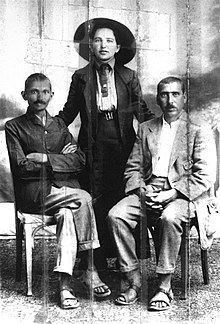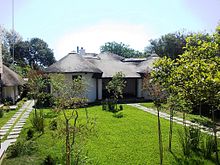Hermann Kallenbach
Hermann Kallenbach | |
|---|---|
 Mahatma Gandhi, Sonja Schlesin, and Kallenbach in 1913 | |
| Born | 1 March 1871 Lithuania |
| Died | 25 March 1945 (aged 74) |
| Resting place | Kibbutz Degania, Israel |
| Nationality | Lithuanian born Jewish South African |
Hermann Kallenbach (1 March 1871 – 25 March 1945) was a Lithuanian-born Jewish South African architect who was one of the foremost friends and associates of Mahatma Gandhi. Kallenbach was introduced to the young Mohandas Gandhi while they were both working in South Africa and, after a series of discussions, they developed a long-lasting association.
Early life
Kallenbach was born in 1871 in
With Gandhi in South Africa

In 1904 he met Gandhi, who was then working in South Africa. They had long discussions on religious and other issues. He was highly influenced by Gandhi's ideas of satyagraha and equality among human beings and became his friend and a dedicated devotee. In Gandhi's words, they became "soulmates" and, for a time, shared what is now called Satyagraha House. This was a house designed by Kallenbach for them both to live together.[3]

In 1910 Kallenbach, then a rich man, donated to Gandhi a 1,100-acre (4.5 km2) farm belonging to him near
Kallenbach also accompanied Gandhi in his first penitential fast at
As a Zionist
Kallenbach planned to accompany Gandhi to India in 1914, but with the outbreak of
Death and legacy
Kallenbach died in 1945. He left a portion of his considerable estate for
Kallenbach was one of the foremost associates and friends of Gandhi, devoting a major part of his life to following his principles and ideals. Gandhi has frequently mentioned him in his autobiography, where he explains how Kallenbach was his 'soulmate'[10] in the early days of the development of his personality and ideology.
A biography of Hermann Kallenbach, written by
A recent book by the writer and photographer Shimon Lev, "Soulmates: The Story of Mahatma Gandhi and Hermann Kallenbach," (Orient BlakSwan, 2012) depicts the relationships between the two idealists, and Gandhi's attitude towards Zionism.
In Richard Attenborough's film, Gandhi, Kallenbach was played by Günther Maria Halmer.[13]
On 2 October 2015, Gandhi's 146th birth anniversary, Lithuanian Prime Minister Algirdas Butkevičius and Indian Minister of State for Agriculture Mohanbhai Kundariya unveiled a statue of Kallenbach and Gandhi in Rusnė.[14]
See also
References
- ^ a b "Artefacts.co.za". Retrieved 3 March 2018.
- ^ "Who was Hermann kallenbach? – Latest News & Updates at Daily News & Analysis". 3 April 2011. Retrieved 3 March 2018.
- ^ "Serene Satyagraha House opens". City of Johannesburg. Archived from the original on 8 July 2015. Retrieved 24 June 2013.
- ^ "For Gandhi, Kallenbach was a friend and guide | Ahmedabad News". The Times of India. 31 March 2011. Archived from the original on 3 May 2012. Retrieved 4 March 2018.
- ^ "Associates of Gandhi : Kallenbach". www.mkgandhi-sarvodaya.org. Retrieved 3 March 2018.
- ^ "Gandhiji's Associates in South Africa". www.gandhi-manibhavan.org. Retrieved 3 March 2018.
- ^ a b "Who was Hermann kallenbach? – Lifestyle – DNA". Dnaindia.com. 3 April 2011. Retrieved 18 July 2012.
- ^ "India's National Archives" (PDF). Retrieved 3 March 2018.
- ^ Christian Bartolf and Isa Sarid: Hermann Kallenbach, 1997
- ^ .j, Kochuthresiamma P. (31 July 2009). "pareltank: Mahatma Gandhi and Hermann Kallenbach". Retrieved 3 March 2018.
- ^ "Truth be told..." Hindustan Times. 30 March 2011. Archived from the original on 30 August 2011. Retrieved 18 July 2012.
- ^ "India buys Gandhi archive to prevent its auction". The Times of India. 10 July 2012. Archived from the original on 12 July 2012.
- ^ Gandhi IMDb.com
- ^ "Lithuania to mark Gandhi Jayanti with new monument to the Mahatma". 30 September 2015. Retrieved 3 March 2018.
Further reading
- Surendra Bhana, "Tolstoy Farm, A Satyagrahi's Battle Ground" Journal of Indian History, 1979, Vol. 57 Issue 2/3, pp. 431–440.
- OCLC 812119425.
